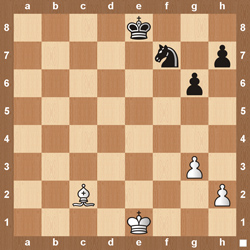Chess Minor Pieces

Chess end game strategy is one of the most important thing a chess player can know. Without a very strong end game it is not possible to be a strong chess player.
In Lesson 1 we take a look at how minor pieces should be evaluated in the end game and how your other pieces and pawns should be looked at depending on the situation.
Minor pieces and pawn structure have similarities in the middle game and end game but also have some big differences. In the middle game you want to use you pawn structure to make a blockade so that your opponent can’t use his bishop. In the end game you want to have your pawns on opposite colors as your opponents bishop so that he can’t attack any of your pawns. If his bishop can’t attack your pawns then his bishop becomes almost pointless.
Another thing to consider is that if there are pawns on both sides of the board it is more important to have bishops but if there are only pawns on one side of the board it favors the side that has knights. This is because the knight can attack/defend every square on one side very easy but can’t go from one side of the board to the other like the bishop can.
Watch the video below to watch more detailed explanations of minor pieces in the end game.